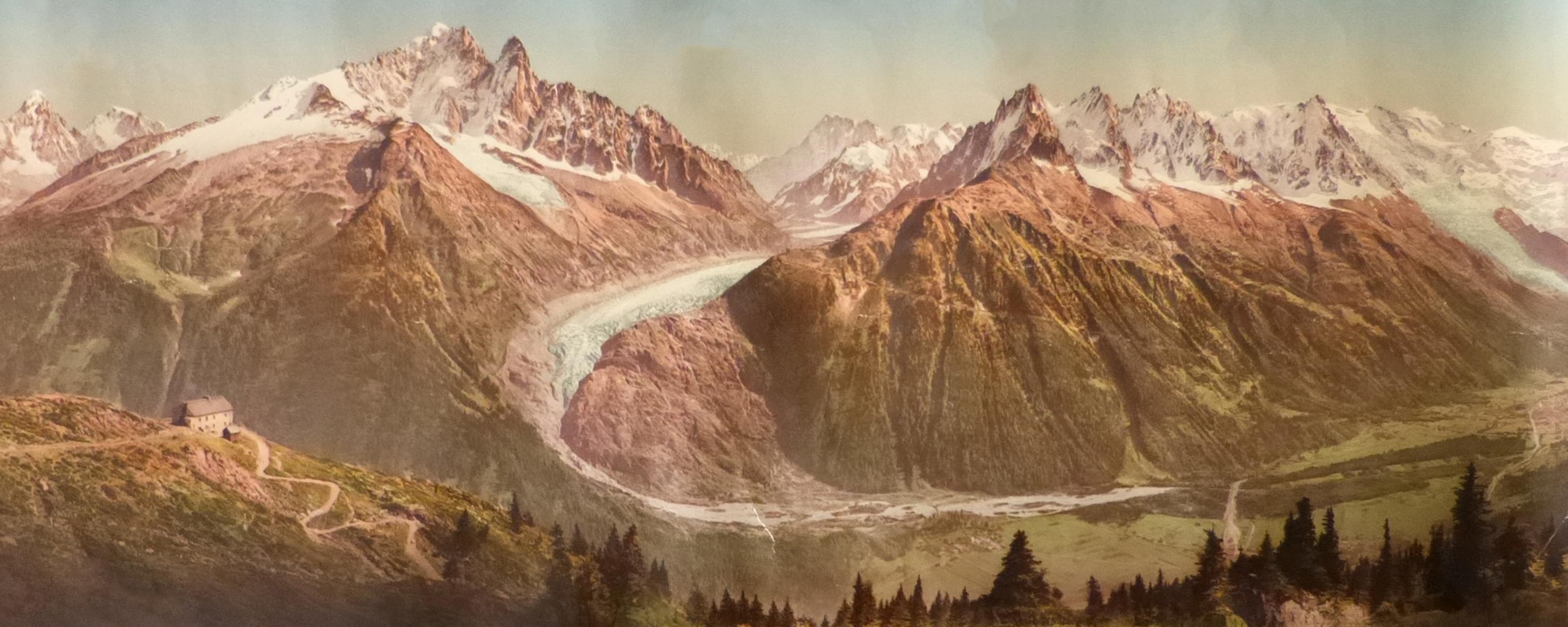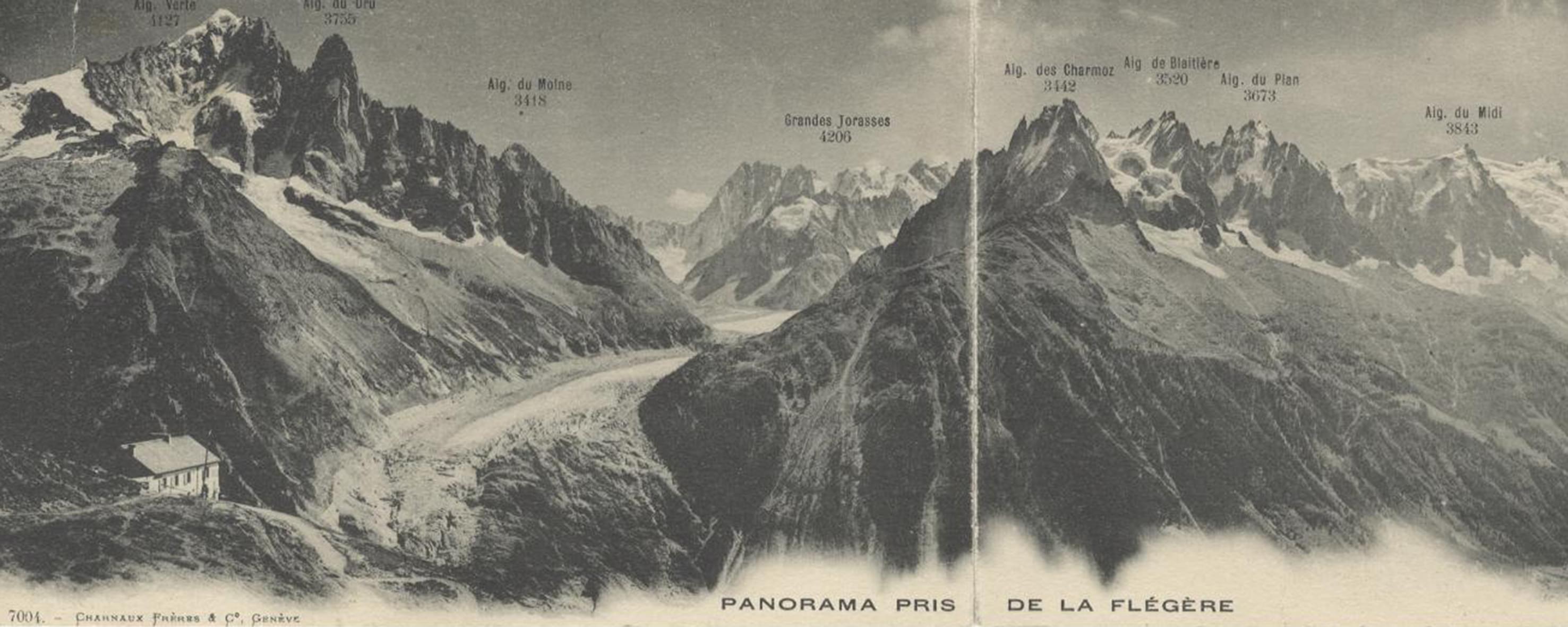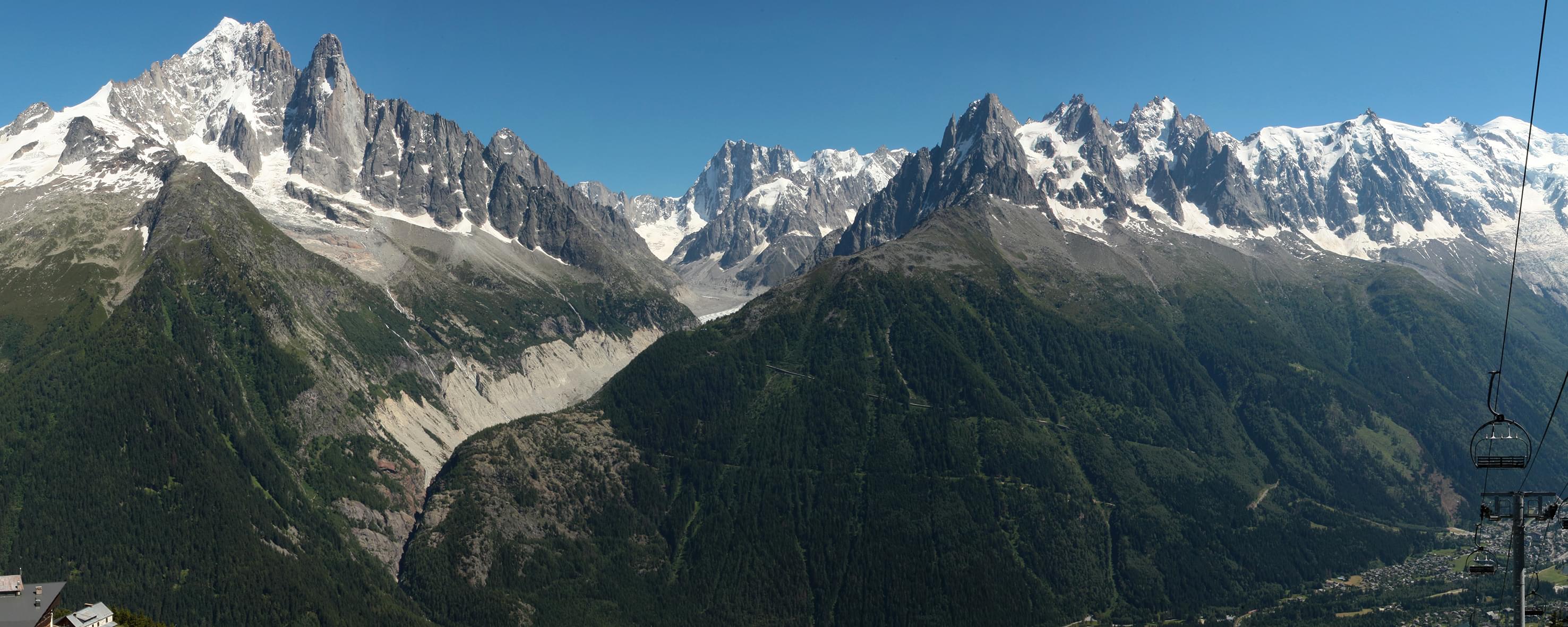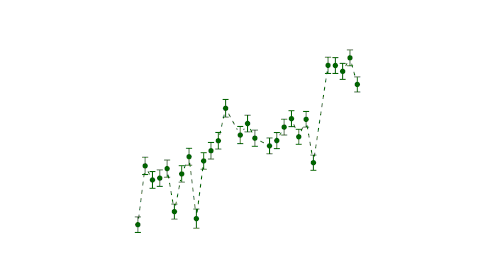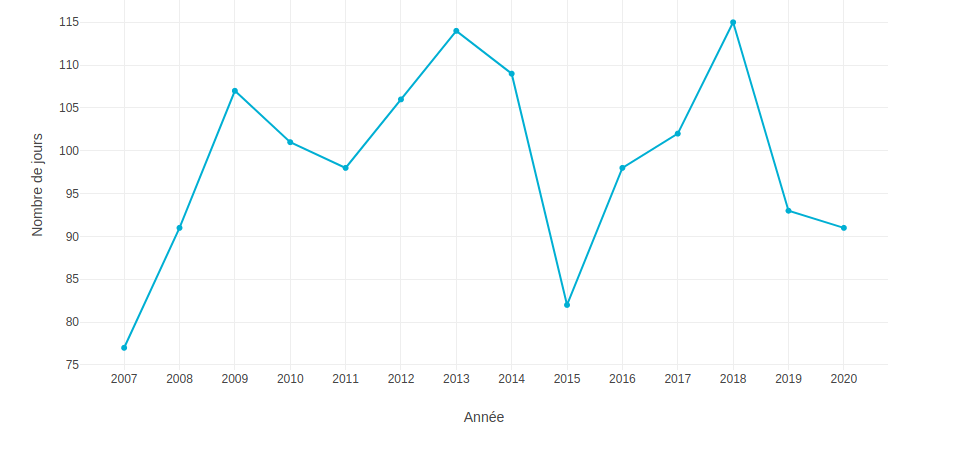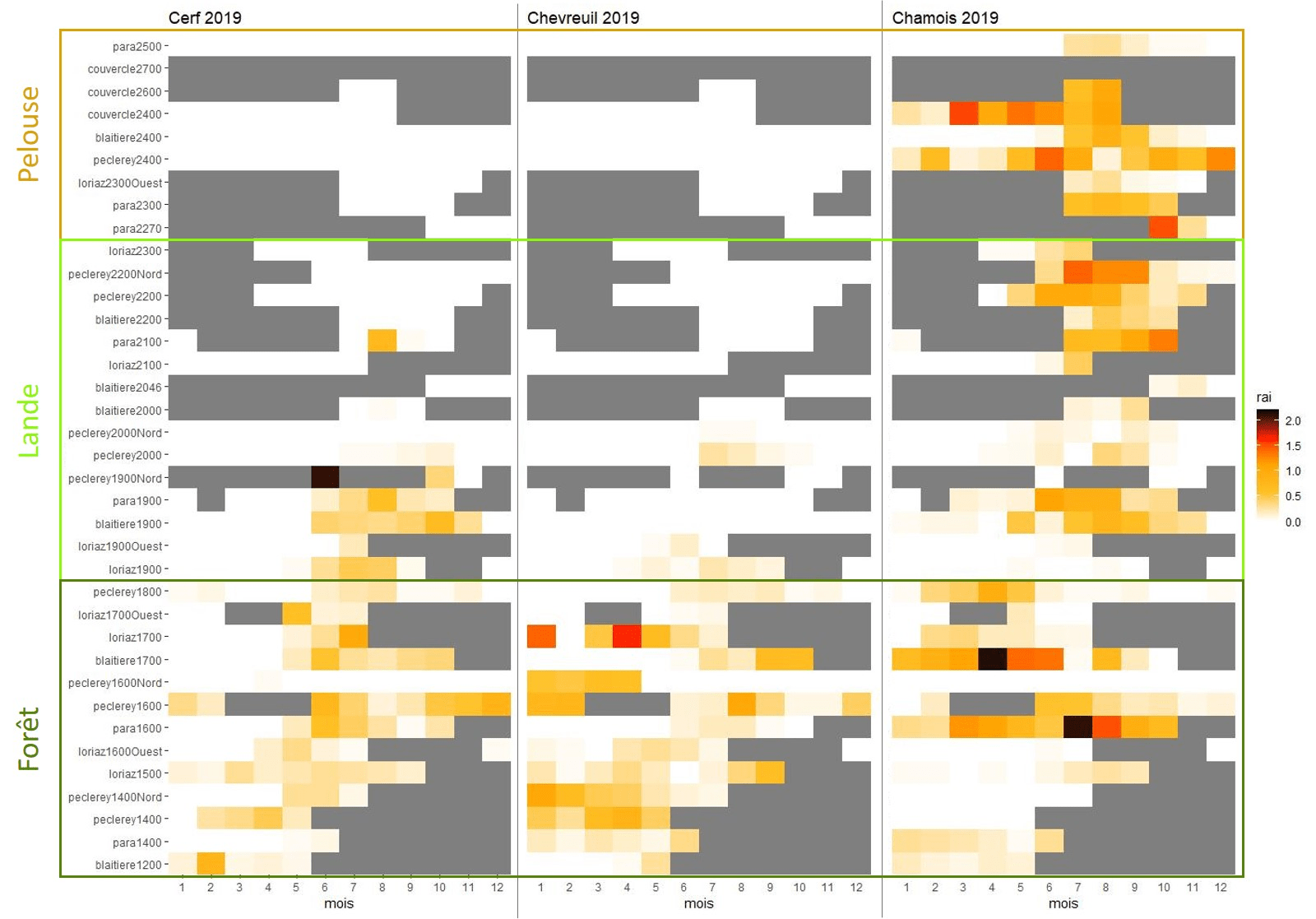Points to remember
- Glaciers are the most visible indicators of climate change.
- The Mer de Glace could disappear by 2100, mainly due to the strain of high summer temperatures.
- The disappearance of the glaciers is a major change for the massif’s tourism and water resources, but perhaps the promise of new areas suitable for endangered alpine fauna.
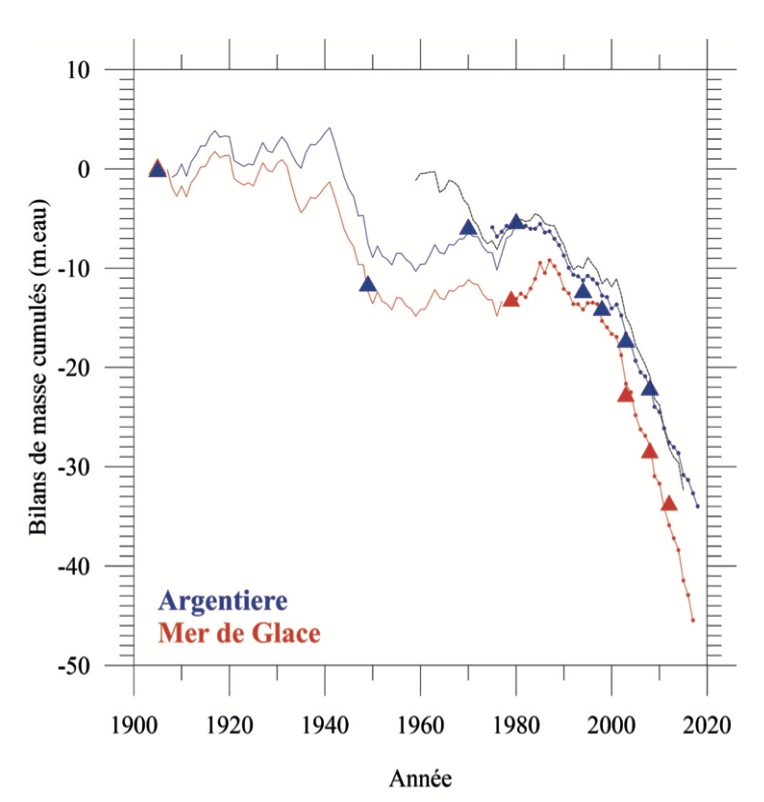
Issue: the Mont Blanc glacier massif
The Mont-Blanc massif is unique because, from 4810m above sea level down to 1427m, glaciers flow down its slopes over an altitude difference of 3383m. Topography, temperatures and snowfall dictate the thickness and velocity of flow, and thus the life of a glacier.
Glaciers at such low altitudes, outside polar regions, are a particular feature of the Mont Blanc massif. They occupy 159 square kilometres with a distribution of 63% on the French side of the massif, 23% on the Italian side and 14% on the Swiss side. This “cryosphere” is, therefore, an essential element of the massif.
It is the snowfall that, through natural compaction, gradually forms the glacier ice. From accumulation zones at high altitude, the ice then flows at a speed which varies annually, depending on the topography and season. A glacier “advances” in keeping with gravity, like a river but in a more imperceptible way. The Mer de Glace thus advances an average of 30m per year in the area of Montenvers.
In addition to its speed of flow, the life of a glacier is determined by its thickness and the mass it gains or loses annually. Temperatures and precipitation influence the glacier’s summer melt or “ablation” as well as the accumulation of snow in cold seasons. The difference between gains and losses of ice is expressed in “metres of water equivalent”. If losses exceed gains, the glacier loses thickness or even surface area when the thickness becomes zero. Another interesting piece of data is the equilibrium altitude at which the glacier neither loses nor gains thickness over a given period.
Relevance: indications of climate change
The retreat of glacier fronts and decrease in ice thickness are obvious signs of climate change. Glaciers in the French Alps have lost about 25% of their surface area since the late 1960s. This loss was more pronounced in the southern Alps (32% in the Ecrins and “only” 10% in the Mont-Blanc massif).
Glacier snouts (their lowermost part) are rapidly retreating. Since the 18th century, the snout of the Mer de Glace has retreated uphill by more than 2.5 km, with a marked acceleration since 2002. It has retreated by 400m in the last 20 years alone.
This retreat of the glacier snouts is corroborated by a decrease in the surface area and thickness of the glaciers. Since the beginning of the 20th century, the Argentière glacier and the Mer de Glace have lost 38 and 50 metres of average ice thickness respectively, i.e. 25 and 32% of their average thicknesses.
It is the rising and increasingly scorching summer temperatures that explain this melting, rather than the winter precipitation which has remained more or less constant. Above a constantly-rising equilibrium line, the ice melt is less pronounced, or even non-existent on the summit of Mont Blanc and the Dôme du Gouter (where the ice reduction was only 3m between 1905 and 2005). At these altitudes, the average annual temperature actually remains negative (-11°C on the Dôme and -17°C on Mont Blanc). As a result, snow continues to accumulate and create ice, depending on precipitation and the wind conditions.
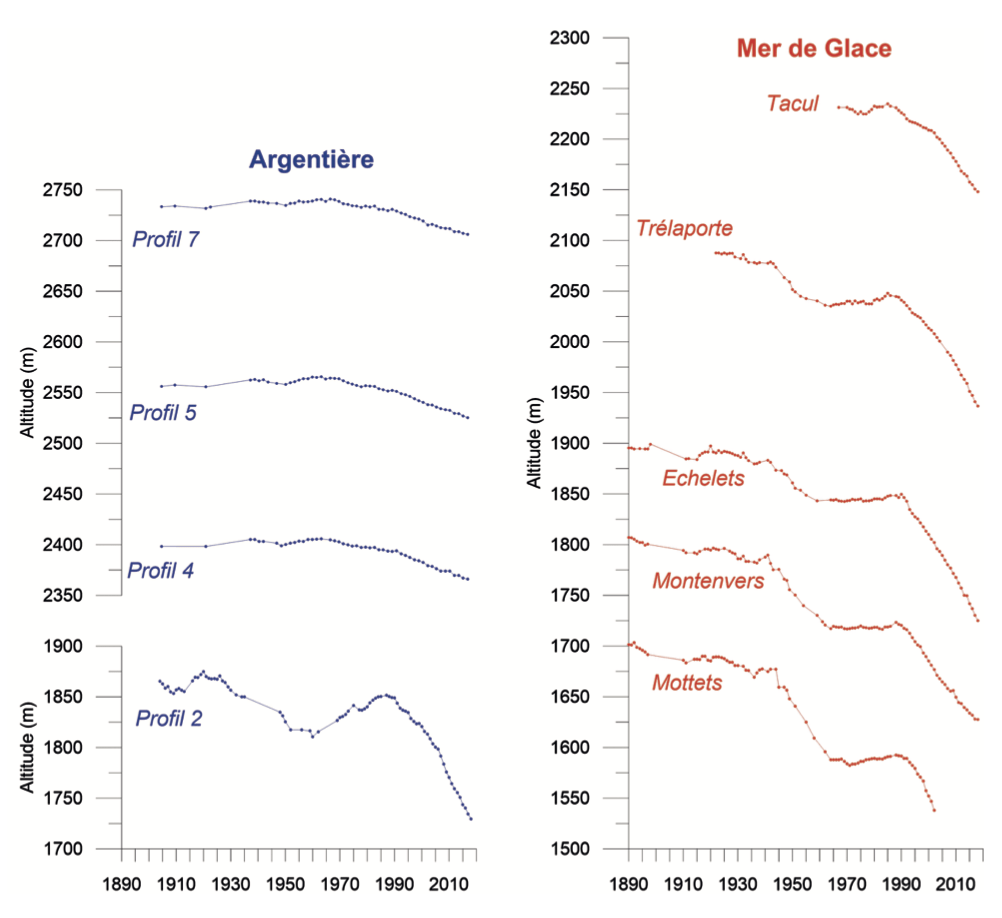
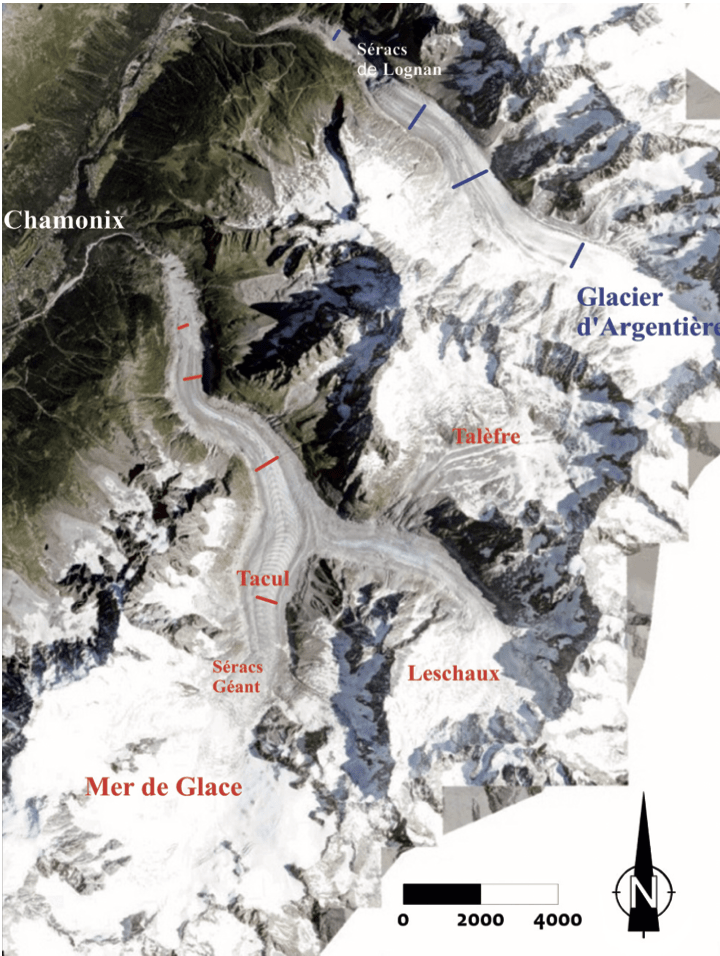
Future outlook for the glaciers
Glaciologists predict the disappearance of 90% of Swiss glaciers and 50% of glaciers on the French side of the Mont Blanc massif by 2090 in a climate scenario which is more optimistic than current trends in greenhouse gas emissions. The Mer de Glace glacier could disappear by 2100 and the Argentière glacier by 2080.
The equilibrium line - where the ice neither melts nor forms over a given period of time - could rise from the current 2900m to 3500m by the end of the century. Temperatures are once again being blamed for this glacial retreat. The number of days of freeze - i.e. when the maximum temperature remains below 0°C - is expected to decrease by more than 25% across the massif by the end of the century, and even by more than 50% in a pessimistic scenario. Above an altitude of 2400m, that means more than a month of freeze disappearing by 2050. The increase in winter precipitation, if indeed it continues, will not be enough to compensate for these rising temperatures.
The Mer de Glace and the Argentière glacier are two emblematic examples of the future disappearance of glaciers in the Mont Blanc massif. Future glacier modelling is tricky because it requires knowledge not only of climate developments and local meteorological variables, but also of the current distribution of ice thickness and a glacier’s bedrock.
The Mer de Glace glacier is expected to split in two within the next decades where the slope drops off at the Géant seracs. The glacier will therefore no longer be fed downstream of this and the ice will stagnate. In an optimistic scenario, the snout of the Mer de Glace will have retreated by 7.2km by 2100 compared to 2018. At the foot of the Aiguille du Midi, there would still be nearly 150m of ice thickness left. In a pessimistic scenario (but currently the most realistic), the Mer de Glace glacier will have disappeared by that date. However, the topography of the rock bed upstream of the Géant serac fall is insufficiently known and remains an uncertainty in the models.
As for the Argentière glacier, a so-called “proglacial” lake downstream from the glacier snout is forecast to appear above the Lognan gradient change from around the 2040s. The glacier could completely disappear before 2080 with the thickest part, currently between 2,800 and 2,900 metres, remaining until last. In the Arve catchment area (on the French side of the Mont Blanc massif), there should only be around forty square kilometres of glacier left by the end of the century, given an optimistic scenario. This becomes, in a pessimistic scenario, even less than fifteen square kilometres around the summit of Mont Blanc.
The outlook for living beings
For humans, glaciers are an important part of the land, positive in terms of tourism or water supply, sometimes more threatening. For wildlife, glacial retreat provides new spaces to occupy, perhaps a future zone of refuge when faced with pressures coming from the climate and people.
Glaciers mainly represented a threat throughout history, particularly during the glacial advances of the 17th century which swept away villages and farmland, or with the explosion of the water pocket on the Tête Rousse in 1892. Serac collapse from the Taconnaz glacier still presents a major avalanche risk, while the future Argentière lake will create a significant flooding risk in the Chamonix valley, if it overflows.
But glaciers also fascinated the first travellers and scientists as early as the 18th century, when the ice was at its most extensive since homo sapiens occupied the Alps. These glaciers are today a natural heritage, bearing witness to the impact of global warming on the planet. They also serve as real water reservoirs and the hydroelectric sector, in particular, knows how to exploit this.
As for flora, the rapid glacial retreat led in less than 10 years to colonisation by pioneer plants and then gradually by other habitats, such as forest. Typical alpine fauna - ptarmigan, for instance - might find refuge in these newly accessible environments: the wildlife being pushed up to higher altitudes by rising temperatures and towards new areas by human activities. Provided, however, that the vegetation essential to animal life establishes itself quickly enough and that these areas remain protected.
References
- Cremonese E., Carlson B., Filippa G., Pogliotti P., Alvarez I., Fosson JP., Ravanel L. & Delestrade A. AdaPT Mont-Blanc : Rapport Climat: Changements climatiques dans le massif du Mont-Blanc et impacts sur les activités humaines. Rédigé dans le cadre du projet AdaPT Mont-Blanc financé par le programme européen de coopération territoriale Alcotra Italie-France 2014-2020. Novembre, 2019, 101 p CH2014-IMPACTS. Toward quantitative scénarios of climate change impacts in Switzerland. OCCR, FOEN, Meteoswiss, C2SM, Agroscope, Proclim, 2014, 136.
- Gardent, M., Rabatel, A., Dedieu, J. P., & Deline, P. (2014). Multitemporal glacier inventory of the French Alps from the late 1960s to the late 2000s. Global and Planetary Change, 120, 24-37
- Laurent L., Buoncristiani J.F., Benjamin Pohl B., Zekollari H., Farinotti D., Huss M., Mugnier J-L. 2020. The impact of climate change and glacier mass loss on the hydrology in the MontBlanc massif. Nature Scientific Report.
- Observatoire des glaciers Glacioclim
- Pohl, B. et al. (2019). Huge decrease of frost frequency in the Mont-Blanc massif under climate change. Nature Scientific Report. 9, 1–7
- Vincent C., Peyaud V., Laarman O, Six D., Gilbert A., Gillet-Chaulet F., Berthier E., Morin S., Verfaillie D., Rabatel A., Jourdain B., Bolibar J. (2019) Déclin des deux plus grands glaciers des Alpes françaises au cours du XXIe siècle : Argentière et Mer de Glace La Météorologie, 106, DOI: 10.4267/2042/70369
Partners
Autres enjeux qui pourraient vous intéresser...

The Mont-Blanc sees red
Temperatures, so crucial to mountain life, are rising. Consequences vary from season to season.
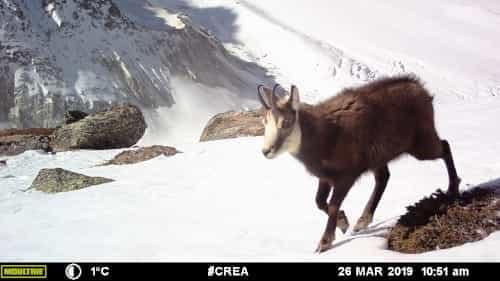
Herbivores at every level
The distribution of wild herbivores is highly dependent on the evolution of vegetation. How will these species adapt to changes in seasons and environmental composition?
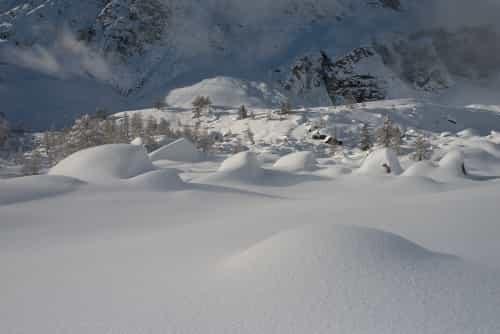
Marked decline in snow cover
Snow is a unique feature of the mountains. Its disappearance at certain seasons and altitudes is a major change for living things.

Each at their own pace but all out of sync
The seasons are getting longer for trees, at an accelerated pace at higher altitudes.







